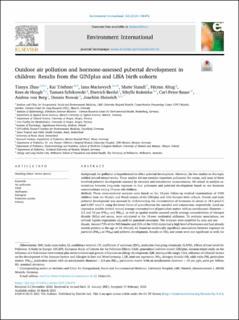| dc.contributor.author | Zhao, Tianyu | |
| dc.contributor.author | Triebner, Kai Philipp | |
| dc.contributor.author | Markevych, Iana | |
| dc.contributor.author | Standl, Marie | |
| dc.contributor.author | Altug, Hicran | |
| dc.contributor.author | de Hoogh, Kees | |
| dc.contributor.author | Schikowski, Tamara | |
| dc.contributor.author | Berdel, Dietrich | |
| dc.contributor.author | Koletzko, Sibylle | |
| dc.contributor.author | Bauer, Carl-Peter | |
| dc.contributor.author | von Berg, Andrea | |
| dc.contributor.author | Nowak, Dennis | |
| dc.contributor.author | Heinrich, Joachim | |
| dc.date.accessioned | 2022-04-20T09:12:58Z | |
| dc.date.available | 2022-04-20T09:12:58Z | |
| dc.date.created | 2021-09-16T15:38:00Z | |
| dc.date.issued | 2021 | |
| dc.identifier.issn | 0160-4120 | |
| dc.identifier.uri | https://hdl.handle.net/11250/2991550 | |
| dc.description.abstract | Background
Air pollution is hypothesized to affect pubertal development. However, the few studies on this topic yielded overall mixed results. These studies did not consider important pollutants like ozone, and none of them involved pubertal development assessed by estradiol and testosterone measurements. We aimed to analyze associations between long-term exposure to four pollutants and pubertal development based on sex hormone concentrations among 10-year-old children.
Methods
These cross-sectional analyses were based on the 10-year follow-up medical examinations of 1945 children from the Munich and Wesel centers of the GINIplus and LISA German birth cohorts. Female and male pubertal development was assessed by dichotomizing the concentration of hormones in serum at 18.4 pmol/L and 0.087 nmol/L using the lower limits of quantification for estradiol and testosterone, respectively. Land-use regression models derived annual average concentrations of particulate matter with an aerodynamic diameter < 2.5 and 10 µm (PM2.5 and PM10), as well as spatial models assessed yearly average concentrations of nitrogen dioxide (NO2) and ozone, were calculated at the 10-year residential addresses. To evaluate associations, we utilized logistic regressions adjusted for potential covariates. The analyses were stratified by area and sex.
Results
Around 73% of the 943 females and 25% of the 1002 males had a high level of hormones and had already started puberty at the age of 10. Overall, we found no statistically significant associations between exposure to particles (PM2.5 or PM10) and pubertal development. Results on NO2 and ozone were not significant as well; for instance, per 10 µg/m3 increase in ozone concentration, odds ratios and 95% confidence intervals were 0.900 (0.605, 1.339) and 0.830 (0.573, 1.203) for females and males, respectively. Stratified by area, the aforementioned results did not reveal any associations either.
Conclusions
Our study did not observe the associations between ambient air pollutants and pubertal development determined by estradiol and testosterone levels in children. However, due to the current limited number of studies on this topic, our results should be cautiously interpreted. Future longitudinal studies are needed to assess the association. | en_US |
| dc.language.iso | eng | en_US |
| dc.publisher | Elsevier | en_US |
| dc.rights | Navngivelse 4.0 Internasjonal | * |
| dc.rights.uri | http://creativecommons.org/licenses/by/4.0/deed.no | * |
| dc.title | Outdoor air pollution and hormone-assessed pubertal development in children: Results from the GINIplus and LISA birth cohorts | en_US |
| dc.type | Journal article | en_US |
| dc.type | Peer reviewed | en_US |
| dc.description.version | publishedVersion | en_US |
| dc.rights.holder | Copyright 2021 The Author(s) | en_US |
| dc.source.articlenumber | 106476 | en_US |
| cristin.ispublished | true | |
| cristin.fulltext | original | |
| cristin.qualitycode | 1 | |
| dc.identifier.doi | 10.1016/j.envint.2021.106476 | |
| dc.identifier.cristin | 1935033 | |
| dc.source.journal | Environment International | en_US |
| dc.identifier.citation | Environment International. 2021, 152, 106476. | en_US |
| dc.source.volume | 152 | en_US |

